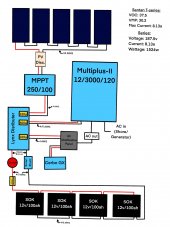jameshowison
New Member
- Joined
- Jul 30, 2021
- Messages
- 184
Hah, Not me, I’ve got Jakiper batteries hooked up to Victron 
Is there a reason for this?Anybody else cringe when they hear EG4 and Victron used in the same sentence?
At this point, Maybe a 48v system would make even more sense. Because the 48v Eg4 has a 100ah max discharge, which would solve my problem there too.A 24v system would look basically the same, with three main differences:
Its hard to find inverter/chargers of the capacity you need in 48 volts.At this point, Maybe a 48v system would make even more sense. Because the 48v Eg4 has a 100ah max discharge, which would solve my problem there too.
You didn't answer my question about your RV being a 50 amp@240VAC shore power.At this point, Maybe a 48v system would make even more sense. Because the 48v Eg4 has a 100ah max discharge, which would solve my problem there too.
Ah sorry! No, it is 30aYou didn't answer my question about your RV being a 50 amp@240VAC shore power.
I am tempted to go back to my original plan of using the LV6548 and an Eg4. That seemed so much simpler.Its hard to find inverter/chargers of the capacity you need in 48 volts.
When you picked the multiplus 2 at 12 volts I assumed you would be using this one.I am tempted to go back to my original plan of using the LV6548 and an Eg4. That seemed so much simpler.
This inverter/charger comes in all the popular system voltages .
Yes its additive and another battery will the problem.
If the grid is available you might try this featureYes! This was the one I was planning on.
Going back to this. Lets say I was firm on only needing the one battery. Are there other failsafes I could put it place to protect the battery? Can the inverter or shunt be programmed to not allow more than 200a discharge?
I will look into this more. I think I am leaning towards building a more traditional battery bank with SOK batteries now anyways. I've taken everyones advice and re-planned my system and this is what I have now: (IDK why it exported so crooked.. lol)If the grid is available you might try this feature
If it is available in your version of the MP2.10. Description of Settings
www.victronenergy.com

The smart shunt also has a small DC positive power connection (with its own inline fuse). So that either doubles up on a distributor stud or you can feed it from the 12v RV distribution panel.
The Victron inverter/chargers aren't protected against reversed polarity, so I put a hardwired surge protector thing in before the AC-in. https://hughesautoformers.com/product/pwd30-epo-h/. You might already have one that goes on the campsite pedestal.
You will probably need a grounding bar for the inverter, the Lynx and the MPPT, there aren't enough spots on the negative on the Lynx distributor, but check the explorist.life drawings?
My plan was to do it this way to allow me to add another 5 panel array on the ground (5s2p) if I want to in the future.Actually that said, the 250/100 is way more amps than needed ... rock that victron calculator and save some bucks? If you can't get the VOC down, then at least go down to the 250/60, no?
Ah, I knew I forgot something!
My RV is going to be parts permanently in the AZ desert so the shore plug will likely only be used for a generator as needed, but I guess a little extra protection never hurts.
This helped me with thinking about RV system grounding: https://diysolarforum.com/resources/grounding-made-simpler-part-4-mobile-systems.159/I'm really confused when it comes the grounding. The Explorist.Life diagram has a chassis ground off the Lynx's negative post. I've seen some people discussing an 8ft copper pole that you have to attach to. D you know any other good resources for info on grounding? Does the fact that I won't be plugging into shore make a difference?
Makes some sense, although it's also possible to "over-panel" the smaller victron MPPT. I haven't done this, but check out: https://community.victronenergy.com...ling-a-victron-charge-controller-and-the.htmlMy plan was to do it this way to allow me to add another 5 panel array on the ground (5s2p) if I want to in the future.
Thank you for this!This helped me with thinking about RV system grounding:
That makes sense! I think the smallest the MPPT calculator recommended though was the 250/85. (I am assuming a high Temp coefficient because it isn’t listed in the site and these panels are refurbs) Which still saves me a couple hundred bucks now, but I’m okay with spending a little more to keep my options open. (I have 10 panels to work with and haven’t fully decided how I’m going to position them)Another possibility is a second MPPT for a possible future array. Two smaller MPPT are less expensive (I think?) and maybe can also help with shading (ie RV in the shape, external panels in the sun), even better than parallel (again, I'm not super sure about that).


